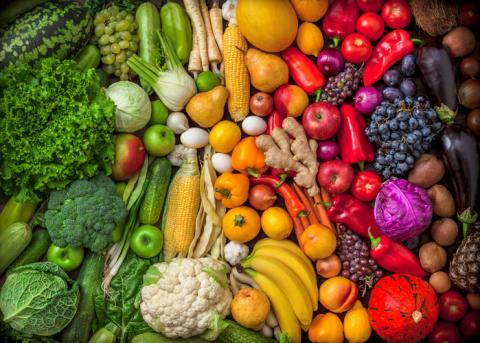Pesticide Contamination: What You Should Know Before You Buy Produce
Here are two things health experts agree on:
1. Americans consume too few fruits and vegetables for optimal health: In fact, more than 75 percent do not meet the USDA's recommended intake (2.5 cups of vegetables and 2 cups of fruit a day, for a 2,000-calorie daily diet).
2. The benefits of eating conventionally grown fruits and vegetables outweigh the potential risks of exposure to minuscule residues of the synthetic pesticides used. (The undisputed danger of pesticides is to the environment and to farmworkers who are routinely exposed to high levels of these toxic chemicals.)
In other words, Americans should be eating more fruits and vegetables, no matter how they are grown—conventionally (with synthetic pesticides) or organically (without them).
Still, there's growing concern that pesticide residues may have subtle health effects, especially in developing fetuses, infants, and children, who are more vulnerable to pesticide toxicity. Thus, it makes sense to minimize exposure to pesticides on produce when possible.
One way to do this, of course, is to buy organic—but because these foods cost more, it can be hard, if not impossible, on your budget to feed your family a totally organic diet. You might instead opt to limit organic purchases to those fruits and vegetables that tend to have the most pesticide residues and fill the rest of your grocery basket with conventional foods.
With that in mind, the nonprofit Environmental Working Group (EWG) ranks fruits and vegetables every year, from most to least contaminated, based on large-scale testing by the USDA and the FDA of both domestic and imported samples. According to EWG, there are "stark differences among various types of produce," in terms of their pesticide residues.
The 2018 list includes 47 types of produce, with the 12 most-contaminated ones deemed the "Dirty Dozen" and the 15 with the lowest pesticide loads called the "Clean Fifteen." All samples were rinsed (under cold running water for 15 to 20 seconds without the use of soaps or special washes) or peeled before testing, just as you would (or should) do at home. While that reduces pesticide residues, it does not eliminate them all (some migrate below the surface), as this report shows.
Of note, most produce that tested positive for pesticide residues had levels that fell well below the "tolerance" levels set by the EPA, though EWG maintains that these are not necessarily safe levels. Also, the methodology used by EWG integrates six different rankings for the presence and levels of pesticides, but it does not necessarily represent the actual toxicity or hazard from eating the produce.
Another thing to keep in mind: Buying organic does not guarantee that your produce is 100-percent free of pesticides, since "organic" is a production term and does not mean "pesticide-free." Some organic produce may have residues of botanical pesticides (presumably safer) and of several synthetic pesticides allowed in organic production, or it may be contaminated due to pesticide drift from nonorganic farms onto organic fields—though levels overall are lower than in conventional produce.
Strawberries: not so pretty
For yet another year, strawberries topped the Dirty Dozen list, followed by spinach, nectarines, apples, grapes, peaches, cherries, pears, tomatoes, celery, potatoes, and sweet bell peppers. Among the more notable findings:
More than 200 pesticides or pesticide breakdown products were detected on the fruits and vegetables that were tested. Almost 70 percent of samples overall had residues of at least one pesticide.
One-third of the strawberry samples tested positive for 10 or more pesticides, with one sample having 22 different ones.
Nearly all spinach samples (97 percent) had detectable residues of at least one pesticide, with a high number having permethrin, a "neurotoxic bug killer" that is banned in the European Union.
One-third of the cherries had detectable residues of iprodione, a pesticide linked to cancer that is banned in Europe.
Pears joined the Dirty Dozen list in 2017 for the first time, rising from 22nd most contaminated in 2016 to 6th most in 2017 and now slightly down to 8th place. More than half of pears had five or more pesticides.
Hot peppers did not meet traditional Dirty Dozen criteria but were singled out (again) because USDA testing found that a portion of them had residues of three pesticides that are highly toxic to the human nervous system—acephate, chlorpyrifos, and oxamyl—at levels high enough to be of concern. The EPA had proposed banning chlorpyrifos under the Obama administration, but Scott Pruitt, under the Trump administration, reversed that decision shortly after being appointed head of the EPA.
Sweet news for avocado and corn
The Clean Fifteen—produce with the lowest pesticide loads—are avocados, sweet corn, pineapples, cabbage, onions, sweet peas (frozen), papayas, asparagus, mangoes, eggplant, honeydew melon, kiwi, cantaloupe, cauliflower, and broccoli.
Of the 360 avocados sampled, less than 1 percent had detectable residues, and none had more than one type of pesticide. Less than 2 percent of sweet corn had residues.
No residues at all were detected in more than 80 percent of pineapples, papayas asparagus, onions, and cabbage.
Broccoli got cleaner this year (moving into the Clean Fifteen list), while grapefruit, which was 15th last year on this list, got dirtier: It now ranks as 22nd least contaminated out of 47 types of produce.
BOTTOM LINE: In most cases, pesticide residues were below safety levels set by the EPA. But by opting for organic versions of fruits and vegetables on the Dirty Dozen list and choosing conventionally grown produce on the Clean Fifteen list, "you can have the health benefits of a diet rich in fruits and vegetables while limiting your exposure to pesticides," according to EWG. Buying organic also "sends a message that you support environmentally friendly farming practices that minimize soil erosion, safeguard workers, and protect water quality and wildlife." Whatever produce you select, wash it well under running water. To find out how the produce was tested and get the full list, go to ewg.org/foodnews/summary.
